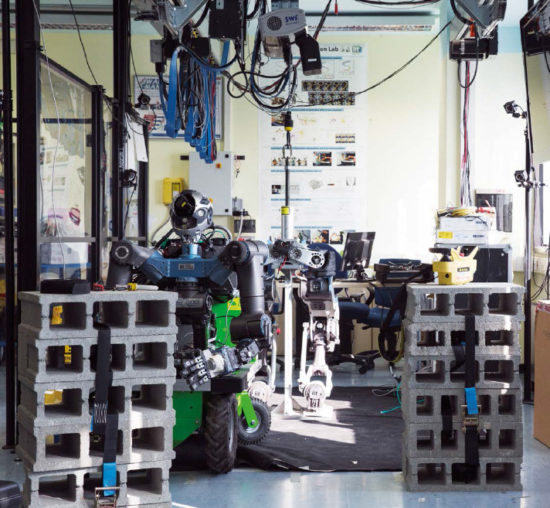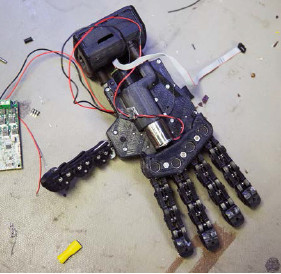Published: Saturday December 31 2016Robots used to be separated from people because of safety concerns, but Professor Antonio Bicchi of the Italian Institute of Technology and Pisa University believes that a new generation of lightweight, soft robots will safely interact with humans in everyday life.The robots that play an essential role in many industries today are rigid and heavy, their mechanical and electronic components programmed by humans to be very accurate in what they do. But as researchers have learnt more about how the human body performs complex tasks, the world of robotics is moving towards devices that operate more like humans – and can interact with them.According to Antonio Bicchi, Professor of Robotics at the University of Pisa in Italy and head of the SoftBots Lab at IIT, industrial robots will no longer have to be segregated in cages to protect people from injury. Instead, they will help humans on the production line, and also in services where they will be able to assist people such as the elderly and disabled by interacting with them. ‘There will be a change of paradigm,’ he says.‘We are moving from an age of information, which has deluged us with information through media such as smartphones and television, to an age of machines that can interact with people physically and intelligently.
Topics:
Perspectives Pictet considers the following as important: In Conversation With, Pictet Report, robotics, soft robots, SoftBots
This could be interesting, too:
Perspectives Pictet writes House View, October 2020
Perspectives Pictet writes Weekly View – Reality check
Perspectives Pictet writes Exceptional Swiss hospitality and haute cuisine
Jessica Martin writes On the ground in over 80 countries – neutral, impartial and independent
Robots used to be separated from people because of safety concerns, but Professor Antonio Bicchi of the Italian Institute of Technology and Pisa University believes that a new generation of lightweight, soft robots will safely interact with humans in everyday life.
The robots that play an essential role in many industries today are rigid and heavy, their mechanical and electronic components programmed by humans to be very accurate in what they do. But as researchers have learnt more about how the human body performs complex tasks, the world of robotics is moving towards devices that operate more like humans – and can interact with them.
According to Antonio Bicchi, Professor of Robotics at the University of Pisa in Italy and head of the SoftBots Lab at IIT, industrial robots will no longer have to be segregated in cages to protect people from injury. Instead, they will help humans on the production line, and also in services where they will be able to assist people such as the elderly and disabled by interacting with them. ‘There will be a change of paradigm,’ he says.
‘We are moving from an age of information, which has deluged us with information through media such as smartphones and television, to an age of machines that can interact with people physically and intelligently. ‘That means robots which will do tasks and jobs, with bodies that can act on their environment.

This opens up a completely new scenario for researchers: instead of rigid, heavy robots which are dangerous and uncomfortable to be around, we will create robots which are no longer massive and rigid but softer – using plastics and elastic materials that resemble the structures found in human bodies.’ A good example which Prof Bicchi has been working on with the Italian Institute of Technology is a humanoid robot that can assist in search and rescue operations. The response to Japan’s Fukushima nuclear disaster was seen as weak, and the US’s Defense Advanced Research Projects Agency (DARPA) organised a competition in 2015 to devise robots that could assist in such events.
‘We worked on a model with a torso, a head and hands that could do tasks such as driving a car, turning a valve, climbing stairs and opening doors. At almost 2 metres high and weighing 150 kilogrammes, it is powerful enough to do heavy jobs, but also has the soft characteristics that enable it to adapt to its environment and work with humans.
‘Recently it was tested after the Amatrice earthquake in central Italy, where it was used to enter a building that had been damaged and take measurements to see if it could be entered safely. It was controlled by a pilot wearing a virtual reality mask which allowed him to see what the robot could see. He could also move the robot’s head and arms by moving his own head and arms, so that objects of value could be saved. The robot was like an avatar – it impersonated the pilot.’
Another field in which Prof Bicchi has led research is haptic interfaces, technology that gives robots the ability to feel things when they are touched. Vision is already well developed in robots through cameras and image analysis, but touch – which is just as important to humans – is much less developed.
‘With the search and rescue humanoid, for example, the pilot has 3D vision and knows where to put the hand to find an object. But the lack of tactile feedback is a handicap when trying to pick something up and not drop it, and it is not easy to replicate the human sense of touch.
‘Our approach was to realise that we do not need all the information that comes from our fingertips, and should focus on the most important – such as vibration. My leitmotif is always to make technologies simple, particularly with touch where the human body’s processes are incredibly complicated.
‘So that is an example of how learning the ways that humans work can help design better robots and better human interfaces. Previous designs of robotic hands since the 1980s had been very sophisticated, with many degrees of freedom. But they had proved too complicated to be used in industry or in prosthetics, so we are designing hands that can do a good part of what humans can do with theirs, with the same simplicity of human use.’
Prof Bicchi graduated in Bologna as a mechanical engineer, where he took his doctorate in control engineering with a thesis on robotic hands. He continued his work on robotic hands at post-doctoral level, first at the Massachusetts Institute of Technology Artificial Intelligence lab, and then leading the Robotics group at the E. Piaggio Research Centre of the University of Pisa. But in 2000, he took a pause from that line of research because he felt that they were producing hands that were not making much impact.
After 10 years, he made an unexpected breakthrough when he met Professor Marco Santello, a neuroscientist from Arizona State University who had given a conference paper on the neuroscience of hand control. This started a collaboration between the two men which led Prof Santello to develop the idea of simplification, looking for the most fundamental components that made human hands dextrous in grasping objects.

‘We called these components synergies that could be copied for robotic hands. We identified just two of the most common movements in the human hand which explain more than 80 per cent of the grasping that we do in everyday life. So to simplify robot hands, we had to make them do what human hands can do by using one or two of these synergies.’
The collaboration continues, with Prof Santello working closely with Prof Bicchi, who is now an Adjunct Professor at Arizona State. The Italian team has 50–60 people, largely undergraduates split between Pisa and the Italian Institute of Technology which is in Genoa. In addition to finance from the European Commission as part of EU projects, the research group benefits from private funding for commercial projects.
He sees his most exciting challenge as the SoftHand-Pro project which is applying his work to prosthetic hands, with other European partners and US institutions including Arizona State University. ‘Amputees in the US are beginning trials with our hands, and the initial results are very encouraging,’ he says.
‘They are finding them simple to use, which is very important – if there is something complicated to be controlled by the arm, they will get tired and abandon the prosthesis. Simplicity is the key to success, but so is the robustness of the hand. It is very rewarding to translate what we have learnt by studying human hands back to people who have lost their hands.’
